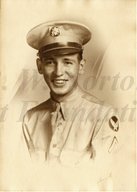
|

|
|
|
|
James was born in Junction City, Arkansas, as one of two sons of Oscar William Thurmon and Lizzie Lou Simmons Thurmon, and grew up on the family farm. His father, a World War I veteran, farmed and worked as a contractor in carpentry. James also did carpentry work, often teaming with his father on projects such as building Louisiana Ordnance Plant near Minden. "Later, my crew dropped some bombs" made at that plant, he says. He also helped on the farm, raising cotton, corn, soybeans, and a velvet bean upon which they fed livestock. They family ate what they grew in a one-acre garden, along with pork that they preserved in salt, he recalls. "We ate lots and lots of vegetables," he says. They kept milk cool in the well. The family was thrifty and purchased only a few commodities, such as flour, from nearby Summerfield. His mother even made her dresses and the boys' shirts out of flour sacks. "We lived on as little as fifteen hundred dollars cash out of pocket a year," he recalls. After graduating from Summerfield High School in 1938, James was working at the ordnance plant when he married Buna Williamson on November 2, 1941. They would have four children, six grandchildren, and six great-grandchildren. Volunteering for the U.S. Army Air Forces, he took basic training at Sheppard Field in Wichita Falls, Texas, then entered airplane mechanics school at Gulfport, Mississippi, where he remained for 22 weeks. At aerial gunnery school in Kingman, Arizona, he trained first with shotguns in skeet shooting, then on 50-caliber machine guns. He learned the parts of the weapon by taking it apart and re-assembling it blindfolded. At Barksdale Field in Bossier City he trained in the B-26 as a turret gunner. Among his crew he recalls Frank Dillard as pilot, Arnold Carr as tail gunner and Conrad Bonham as waist gunner. He and his crew reported to a base in England near Matching Green, from where he flew his first few missions, bombing railroad yards and bridges. "We made about the longest mission we ever made on D-Day," he says, recalling looking down at the vast armada in the English Channel. "I have never, never seen the likes of boats of all kinds that were there," he recalls. They ranged in size from "pretty-good sized ships" to "rowboats." That morning, he recalls being awakened by men running through the barracks shouting, "`D-Day is here! D-Day is here!' We all threw something at him and told him to get out of there." After the invasion the crew began flying out of France as part of the 391st Bombardment Group in a plane the crew called "O Frankie." They lived in a barn beside makeshift airstrips. While he was served hot meals "mostly every day," his diet was supplemented with packages of cookies and cakes his parents sent him. Meanwhile the "O Frankie" bombed marshalling yards, bridges, and other targets, such as submarine pens, dropping 250-, 500- and 2,000-pound explosives. Occasionally, he says he saw "LOPD" for Louisiana Ordnance Plant printed on the bombs. He often flew two missions a day, each averaging about four hours. Although he saw only one German fighter in 65 missions, flak was so thick "you could get out there and walk on it," he recalls. "I guess the Lord must have had his eye on me because not a man in our crew got any wounds, not a one," he reports. James was injured only once, when he broke a collarbone in a bicycle collision. After the war, he came home aboard a hospital ship, although he was not injured. The voyage to New York took 21 days. He was discharged at Camp Shelby near Hattiesburg, Mississippi in September of 1945 as a staff sergeant. Back home, he spent 30 days in Middlepark Bottom hunting and fishing, and unwinding from combat. Afterward he joined his father in working in housing construction. By the mid-1950s he worked for Mid-Valley Pipe Line as a carpenter, then mechanic. He also built a dairy barn, later selling the operation. |


